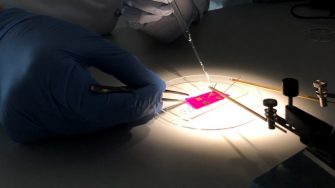
Gene silencing drug delivery
Cancer is a major global problem with an estimated 9.6 million cancer-related deaths in 2018 (World Health Organization, 2018). Despite our increased understanding in the genetic profile of cancer and aggressive treatment, chemotherapy resistance and tumour relapse are common. At the Australian Centre for Nanomedicine we are using an interdisciplinary approach to tackle this disease with the design and synthesis of novel gene-silencing nanomedicines to inhibit the expression of genes in cancer cells which promote aggressive tumour growth and chemotherapy resistance.
This collaborative research involves highly talented scientists from the Faculties of Medicine, Science and Engineering at UNSW Sydney and utilises pre-clinical in vitro and in vivo models which closely mimic the human clinical setting. Projects in this area of research include design and synthesis of novel polymer nanoparticles for gene-silencing drug delivery, defining / optimising the biological properties required for nanoparticles to deliver gene-silencing drugs to cancer cells, and examining the therapeutic potential of gene-silencing nanomedicines to inhibit tumour growth and increase the efficiency of chemotherapy.
Current projects
Design and synthesis of polymer nanoparticles for RNA-based drug delivery.
RNA-based (siRNA, miRNA mimics and inhibitors) drugs hold great promise for the treatment of many types of human disease including cancer. However, these drugs require a delivery vehicle to enter cells. We are currently developing di-block copolymer-based nanoparticles designed to rapidly self-assemble with RNA using a simple mixing process. Once assembled these nanoparticle complexes are internalised into cancer cells.
Biological characterisation of polymer nanoparticles for the delivery of siRNA/miRNA to cancer cells.
Our polymer-based nanoparticles can deliver therapeutic siRNA with high efficiency to different cancer cells including, pancreatic, lung and brain. We are currently undertaking biological studies to understand the mechanism whereby these nanoparticles are internalised into cancer cells and how they release their drug payload into the cytoplasm. This aspect of the work involves the use of sophisticated real-time microscope imaging combined with 2D and 3D-cell culture models.
Examining the therapeutic potential of gene-silencing nanodrugs for the treatment of cancer.
For this aspect of the work we are using polymer nanoparticles to package and deliver therapeutic siRNA to tumour cells to inhibit genes which play a major role in regulating tumour growth and chemoresistance in adult and childhood cancer. The ability of our RNA-based nanodrugs to inhibit tumour growth is assessed using pre-clinical in vivo models combined with real-time bioluminescent, fluorescent, microCT and MRI imaging.
Multifunctional nanomaterials
Recent progress in material chemistry has enabled the scientists to combine therapeutic and diagnostic agents on a single nanoplatform to simultaneously treat and monitor disease.
This generates a new concept named ‘theranostics’. Different from the conventional therapies, such as surgery, chemotherapy and radiotherapy, where the basic approach is to kill the diseased cells faster than the healthy cells, theranostics aim to treat/repair the specific cells with a probe to visualise disease development, thus enabling personalised medicine. For this purpose, various nanomaterials have been synthesised and used as both drug carrier and imaging contrast agent. Researchers in our centre have been working in the area of theranostics, and developed a variety of multifunctional nanomaterials for disease treatment and diagnosis.
Current projects
- Tumour-selective nanomedicine by delivering catalyst and imaging probes
- Developing multi-mode bio-imaging probes for early and accurate tumour detection
- Constructing theranostic nanoplatforms towards translational nanomedicine
